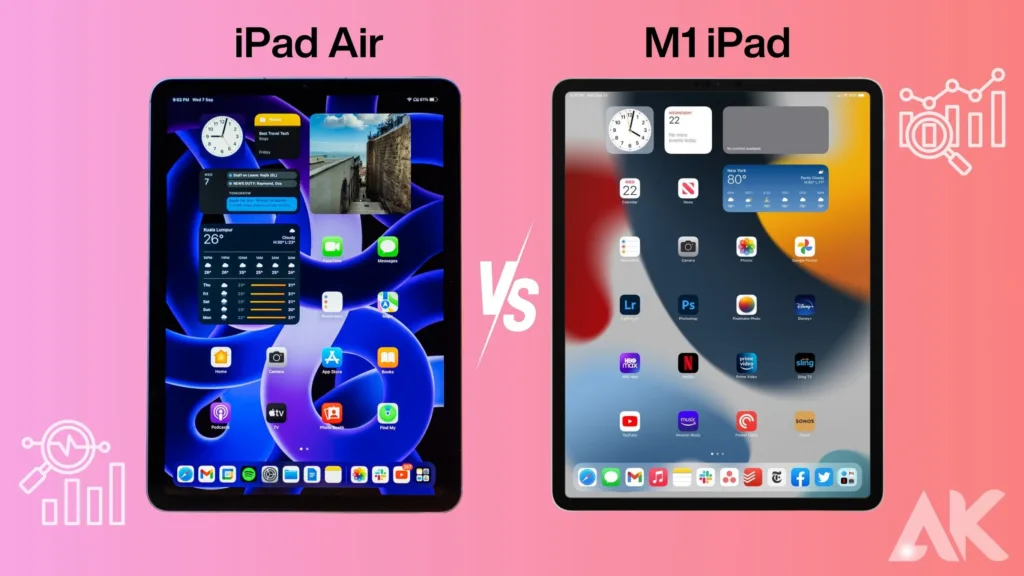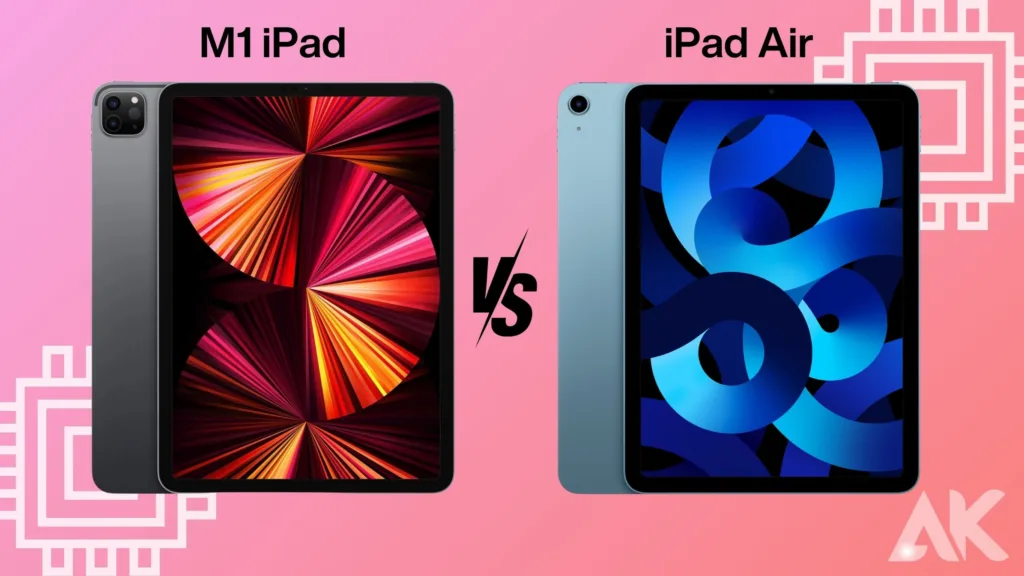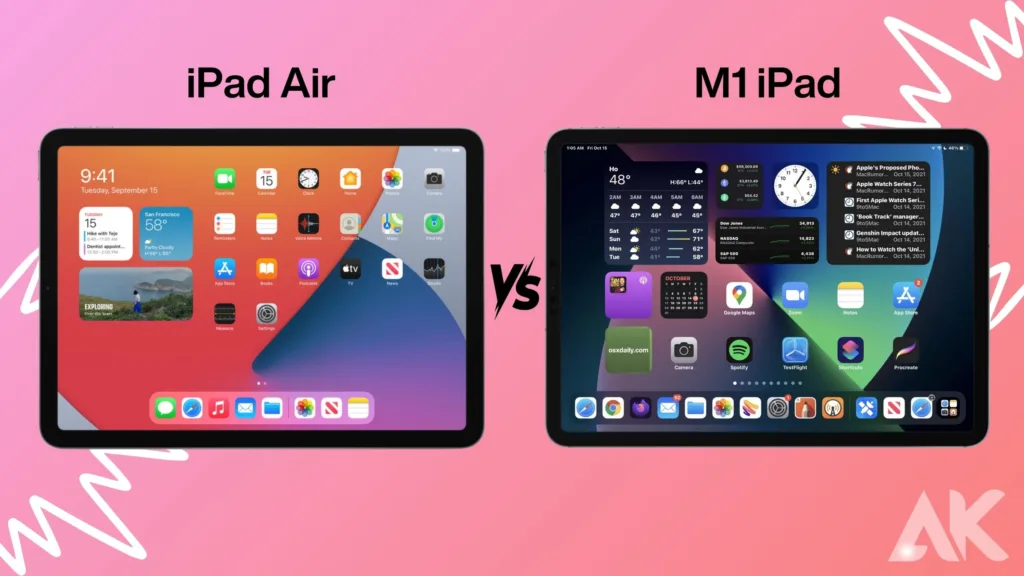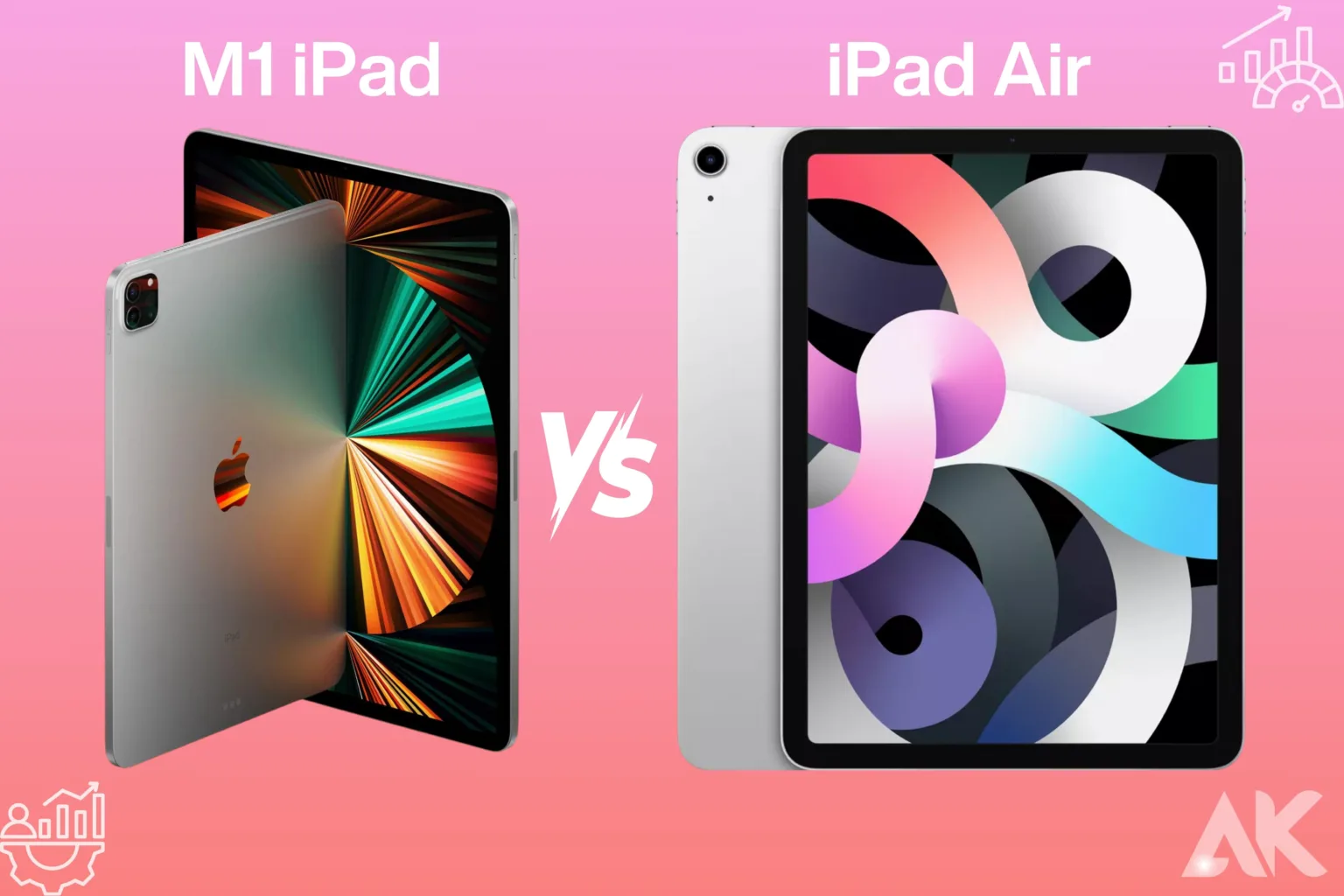iPad Air vs M1 iPad performance Both the iPad Air and the iPad M1 are strong tablets from Apple, but they differ greatly, particularly in terms of performance. The M1 iPad is a more potent tablet with an 11-inch display and the M1 chip—the same chip that powers Apple’s Mac lineup—than the iPad Air, which is a stylish and light tablet with an A14 Bionic chip.
This shows that the M1 iPad has performance comparable to a desktop computer, which makes it perfect for demanding jobs like gaming and video editing. To assist you in selecting the best device for your needs, we will thoroughly examine the performance of these two in this post. We will pay particular attention to their CPUs, graphics, RAM, storage, display quality, battery life, software, user experience, and price.
Overview of iPad Air and M1 iPad

The iPad Air and M1 iPad are both Apple-made tablets, but they differ in a few ways. Compared to the M1 iPad, the iPad Air is thinner and lighter, making it more portable. Its 10.9-inch display is marginally smaller than the 11-inch display of the M1 iPad. The iPad Air is equipped with an A14 Bionic chip, a potent processor that facilitates smooth tablet use. Additionally compatible are the Magic Keyboard and the Apple Pencil 2, which are excellent for typing and drawing.
Conversely, the M1 iPad boasts a larger 11-inch display but is slightly thicker and heavier than the iPad Air. The M1 chip, which is significantly more potent than the A14 Bionic chip, is what it uses. It suggests that the M1 iPad is better for operations like photo and video editing because it can perform multiple tasks at once. Additionally, it works with the Magic Keyboard and the Apple Pencil 2.
While the cameras on the iPad Air and M1 iPad are both good for taking pictures and films, the M1 iPad’s camera is marginally superior. Additionally, you won’t need to charge them for a long time because they both have a strong battery life. When everything is considered, the iPad Air is a decent option if you’re looking for a thin tablet with reasonable performance and display, but the M1 iPad is a better option if you require a more capable tablet for tasks like picture and video editing.
Performance Comparison: Processor

Comparable to a tablet’s brain, the processor manages every operation you perform on it. The iPad Air is equipped with the A14 Bionic chip, a potent CPU that facilitates smooth tablet use. It has no trouble performing tasks like playing games, watching videos, and browsing the internet. In contrast, the M1 iPad is equipped with the M1 chip, which is significantly more potent than the A14 Bionic chip. It suggests that the M1 iPad is better for operations like photo and video editing because it can perform multiple tasks at once. Additionally, because it can run more demanding apps and games that might be released in the future, the M1 iPad is more future-proof.
Both the iPad Air and the iPad M1 are good devices for daily use. When you use social networking apps, view movies, or browse the web, you won’t notice much of a change. You will notice a noticeable difference in performance between the two tablets, though, if you play graphics-intensive games or use demanding apps daily. When it comes to these chores, the M1 iPad is far quicker and more responsive, which makes it a superior option for power users or people who require a tablet for work-related purposes.
Performance Comparison: Graphics

For tasks like viewing films, editing images, and playing games, graphics are important. The A14 Bionic chip in the iPad Air is a powerful graphics processor that can easily perform the majority of workloads. The M1 microprocessor, which powers the M1 iPad, is a more potent graphics processor than the A14 Bionic chip. This indicates that there will be no latency or slowness when using the M1 iPad for more demanding graphical applications, such as editing high-resolution images or playing games with plenty of graphics.
The iPad Air and M1 iPad may not have considerably distinct graphics performance in daily use. Both tablets are capable of easily handling chores like social media browsing and video streaming. However, you’ll notice a noticeable difference in the two tablets’ graphics performance if you use them for gaming or photo and video editing. Because of its more potent graphics engine, the M1 iPad does these activities significantly better, giving it a superior option for consumers who require a tablet for these uses.
Memory and Storage
A tablet’s memory and storage capacity are important elements. While storage is used to hold items like images, movies, and apps, memory, or RAM, is utilized to store data and execute apps. With 4GB of RAM, the iPad Air is sufficient for daily activities like online browsing and movie viewing. Additionally, it has 64GB or 256GB of storage, which ought to be sufficient for the majority of users’ demands. In contrast, the M1 iPad has 8GB of RAM, which is greater than the iPad Air. This means that the M1 iPad is an excellent choice for multitasking or running demanding apps because it can manage multiple apps and tasks at once.
The M1 iPad has the same storage capacities as the iPad Air, but for anyone in need of more storage, there’s a 512GB option as well. For those who have a large collection of images, videos, or programs on their tablet, this is helpful. Because of its more RAM and more storage options, the M1 iPad has a general edge over the iPad Air in terms of memory and storage.
iPad Air vs M1 iPad performance Display Quality
The quality of the tablet’s display is an important factor. Although they both have excellent displays, the iPad Air and M1 iPad vary in a few key ways. The 10.9-inch Liquid Retina display of the iPad Air is one of the types of displays that Apple uses in their products. With a resolution of 2360 x 1640 pixels, it can display text and images with excellent clarity and detail. The 11-inch Liquid Retina display on the M1 iPad, on the other hand, has a resolution of 2388 x 1668 pixels. This indicates that,, compared to the iPad Air, the M1 iPad’s display is somewhat bigger and has a slightly greater resolution. Both displays are ideal for daily use.
They are both excellent for reading books, viewing videos, and browsing the internet since they feature fine details and rich colours. the ProMotion technology, on the other hand, enables the display of the M1 iPad to refresh at a maximum rate of 120Hz. This indicates that particularly when scrolling or using the Apple Pencil, the M1 iPad’s display is more responsive and fluid than the iPad Air’s. Overall, the M1 iPad’s bigger size, higher resolution, and ProMotion technology give it a minor advantage over the iPad Air if display quality is important to you.
Battery Life
When selecting a tablet, battery life is important, especially if you want to use it for an extended period without charging. Although they both have outstanding battery lives, the iPad Air and M1 iPad differ in a few ways. The iPad Air’s battery lasts for up to 10 hours when using Wi-Fi to browse the web, view videos, or listen to music. However, the M1 iPad boasts a battery life of up to 10 hours while utilizing Wi-Fi to browse the web, watch videos, listen to music, or use a cellular data network for up to 9 hours of online browsing.
This indicates that although the M1 iPad’s battery life is slightly shorter than that of the iPad Air, most users should still be able to use it for an entire day on a single charge. The real battery life of both tablets should be sufficient for a full day of use, although how you use the tablet will determine how long its battery lasts. The battery may discharge more quickly if you use it for demanding activities like gaming or video editing. Overall, the battery life of the iPad Air and iPad M1 is good and should be sufficient for the majority of users’ needs.
Software and User Experience
A tablet’s usability and software can have a big impact on how much fun it is to use. iPadOS, Apple’s operating system created especially for iPads, is the operating system that runs on both the iPad Air and M1 iPad. This implies that the user experience on both devices should be comparable, offering features like multitasking, an easy-to-use UI, and compatibility with the Apple Pencil and Magic Keyboard. In addition, iPadOS provides an extensive selection of App Store apps, such as gaming, productivity, and entertainment apps, allowing you to personalize your tablet to what you want.
Both tablets should function smoothly and quickly, but the M1 iPad might have a tiny advantage because of its more potent hardware. This implies that the M1 iPad ought to have no trouble handling more complex activities, which makes it a better option for people who want a tablet for work or who demand the most performance. In general, the iPad Air and M1 iPad provide excellent iPadOS user experiences; but, for individuals who require somewhat higher performance, the M1 iPad might be a better option.
Price Comparison
Starting at $599, the 64GB base edition of the iPad Air is available for purchase. The base edition of the M1 iPad, on the other hand, starts at $799 and includes 64GB of storage. This indicates that, for the base model, the M1 iPad costs $200 more than the iPad Air. For some customers, the M1 iPad’s outstanding performance and more sophisticated features make it worth the extra price over the iPad Air.
When comparing the costs of the two tablets, it’s important to take value for money under consideration. At a lower price point, the iPad Air is an excellent tablet that offers a decent combination of features and performance. However, the M1 iPad costs more and provides more sophisticated features and performance. The iPad Air might be a better option if you’re on a tight budget, but the M1 iPad is well worth the extra money if you require the greatest features and performance. Ultimately, the two tablets’ price disparities correspond to their variations in features and performance, so it’s critical to select the one that best fits your needs and price range.
Conclusion
iPad Air vs M1 iPad performance Both the iPad Air and the iPad M1 are top-notch tablets, each with unique advantages and disadvantages. For people on low incomes, the iPad Air is an excellent option because it is more reasonably priced while maintaining good performance and functionality. However, because of its M1 chip, the M1 iPad has enhanced functions and performance, making it a better option for users who require the highest level of performance.
It’s crucial to take your budget and intended use into account while deciding between the two tablets. The iPad Air is a fantastic option if you require a tablet for regular use, such as viewing films and browsing the web. However, the M1 iPad’s higher price is well worth it if you need a tablet for heavier duties like gaming or video editing because of its better performance.
FAQ
Q1: Is the M1 iPad worth the extra cost compared to the iPad Air?
Yes, the M1 iPad offers significantly better performance and features compared to the iPad Air, making it worth the extra cost for those who need the extra power.
Q2: Can I use the Apple Pencil 2 and Magic Keyboard with both the iPad Air and M1 iPad?
Yes, both the iPad Air and M1 iPad are compatible with the Apple Pencil 2 and Magic Keyboard, allowing you to take full advantage of their capabilities.
Q3: Does the M1 iPad have better battery life compared to the iPad Air?
Yes, thanks to its more power-efficient M1 chip, the M1 iPad offers slightly better battery life compared to the iPad Air.
Q4: Can I expect a better display quality on the M1 iPad compared to the iPad Air?
Yes, the M1 iPad features a slightly larger display and ProMotion technology, which delivers a smoother and more responsive viewing experience compared to the iPad Air.
Q5: Is the iPad Air a good choice for budget-conscious buyers?
Yes, the iPad Air is more affordable compared to the M1 iPad, making it a great option for those looking for a high-performance tablet at a more affordable price point.

